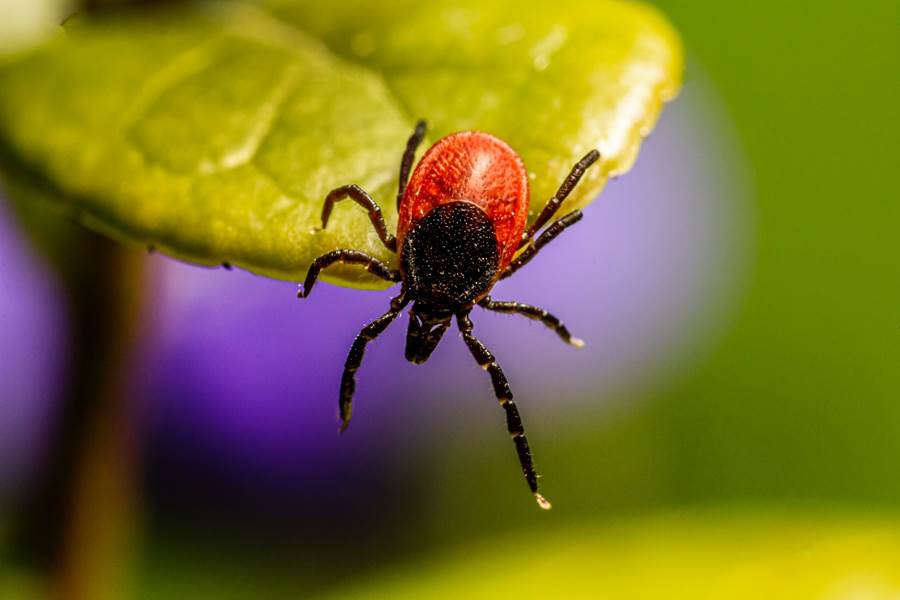Lyme disease, the most common vector-borne disease in the US, is a menace. No doubt about it. And deer fences, properly used, can reduce this menace. No doubt about that either. But the Lyme disease story isn’t simple, and neither is the way deer fences play into it. So, it’s worth taking a look at how the disease works and how deer fences can be used to control ticks with a deer fence.

The disease, spread by the blacklegged deer tick, prevails mostly in an area extending from New England down into Pennsylvania, Virginia, and West Virgina, with notable numbers of cases also occurring in Wisconsin and Minnesota. The total case numbers aren’t known, but estimates based on insurance claims suggest 450,000 to 500,000 cases of Lyme disease per year (1,2).
These numbers are high mainly for two reasons. First, not everyone who gets infected with Lyme disease bacteria seeks prompt treatment. Sometimes the characteristic rash (a red area up to 12 inches across appearing 3 to 30 days after the bite) does not take its usual form or fails to appear. And human nature being what it is, sometimes it’s ignored.
Second, even if treated promptly with doxycycline, the antibiotic of choice, between 10% and 30% of those treated continue to have or develop symptoms. And since repeated treatments have been found ineffective or even harmful, this leaves a large share of those infected with no choice but to let the disease run its course.
That’s unfortunate, because later Lyme disease symptoms can be nasty. They include bouts of severe joint pain and swelling as well as a wide range of neurologic problems–among them meningitis, nerve damage, partial facial paralysis (Bell’s palsy), limb numbness or weakness, and impaired muscle movement. Less common problems include severe fatigue, eye inflammation, hepatitis, and heart problems (3,4).
All this directs us to prevention. As of this writing in late 2023, a potential vaccine is undergoing trials, but no approved vaccine exists. Various recommendations are available for hikers and campers. But most infections are not being contracted by hikers and campers. They are being contracted in the victim’s own backyard. And since the hiker-camper recommendations (“avoid tick habitats,” “treat yourself with an insect repellent,” “wear a long-sleeved shirt and long trousers”) aren’t always practical for gardeners, children, and others who wish to enjoy their yards, this draws attention to the two prime tools used to control ticks in yards – these being tick sprays and deer fences. More studies online show how effective a deer fence can be to protect against Lyme disease (carried by ticks).
Sprays by themselves are a poor answer. Spraying is costly, needs to be repeated every month or so, and offers no way of freeing the yard from an ongoing invasion by more ticks.
In that case, what about deer fences such as those offered by Critterfence? They are a better answer, because they stop the flood of adult ticks and resulting eggs carried into the yard by deer. However, they are powerless to deal with ticks already inside the yard. Nor can they cope with small animals like white-footed mice and chipmunks that may carry tick larvae and nymphs (the deer tick’s pre-adult stages) into the yard, commonly leaving these young ticks infected with Lyme disease bacteria and ready to bite the yard’s human residents.
This suggests a three-pronged approach. By all means erect a deer fence. That’s a critical first step. An affordable, low-visibility deer fence won’t reduce the yard’s attractiveness or utility while making it markedly safer. But reinforce this step by spraying, using tick sprays harmless to people, first to clear the yard of ticks after the fence is installed, and later occasionally to destroy any ticks brought in by small animals. Please visit https://www.critterfence.com/deer-fence to see deer fence information and options.

Beyond that, do some landscape work. Mow down weeds and tall grasses able to provide jumping-off places for ticks seeking a blood meal and remove large and small piles of litter providing potential refuges for white-footed mice, chipmunks, and other critters.
This may sound like a lot; but once your fence is up, the rest is pretty simple—hardly more than good cleanup and maintenance. So, while Lyme disease poses an important health threat, we have good ways of coping with it on a local yard by yard basis.
The best answer, of course, would be to reduce the overabundant deer population and kick the deer out of our suburbs and other Lyme disease haunts. That would control the problem better than a myriad deer fences and reduce the problem to a manageable size. However, difficulty dealing with deer lovers, the hunting lobby, and a maze of state hunting regulations, plus trouble figuring out how to get rid of deer in densely populated human neighborhoods, makes it unlikely that deer will disappear from populated areas anytime soon. Hence, barring eventual emergence of an effective Lyme disease vaccine, deer fences plus the accompanying related measures just described offer the best answer available for making yards safe from the disease.
References
- Schwartz AM, Kugeler KJ, Nelson CA, et al. Evaluation of commercial insurance claims as an annual data source for Lyme disease diagnoses. Emerg Infect Dis. 2021;27(2).
- Kugeler KJ, Schwartz AM, Delorey M, et al. Estimating the frequency of Lyme disease diagnoses —United States, 2010-2018. Emerg Infect Dis. 2021;27(2).
- CDC. Post-treatment Lyme Disease Syndrome. January 10, 2022. https://www.cdc.gov/lyme/postlds/index.html
- CDC. Signs and Symptoms of Untreated Lyme Disease. January 15, 2021. https://www.cdc.gov/lyme/signs_symptoms/index.html